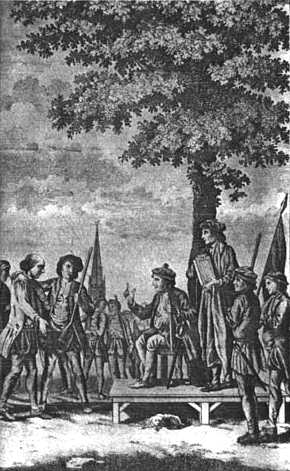Robert Kett facts for kids
Robert Kett was an English farmer and landowner who lived a long time ago, in the 1500s. He became famous for leading a big protest, known as Kett's Rebellion, in 1549. This rebellion happened because many poor farmers were upset about changes to their land.
Contents
Who Was Robert Kett?
Robert Kett was born around 1492 in a place called Forncett in Norfolk, England. He was the fourth son in his family. People think he worked as a tanner, which means he prepared animal hides to make leather. He also owned land in a town called Wymondham.
Why Did People Protest?
In the 1500s, many rich landowners started to "enclose" common lands. This meant they put fences around land that everyone used to share for farming or grazing animals. This made it very hard for poor farmers to feed their families. People were also unhappy with the government's rules at the time, especially those made by the King's main advisor, Edward Seymour.
The Start of the Rebellion
Robert Kett and his brother William lived in Wymondham. They had a disagreement with a man named John Flowerdew, who had put up fences on common land. Robert Kett and the people of Wymondham tore down Flowerdew's fences. This made Kett well-known.
In July 1549, a local celebration in Wymondham turned into a riot. This was the signal for a bigger protest to begin across Norfolk. Robert Kett stepped up to lead the angry farmers.
Leading the Rebels
Kett led his followers to the city of Norwich. They set up a large camp on a place called Mousehold Heath. It's said that about 16,000 men joined him there. Kett was a strong leader. He set up rules for his camp, made sure things were organized, and even held court to settle arguments among his followers. They also blocked off Norwich.
The rebels wrote down their demands in a list of 29 points. These points asked for changes to the land rules and other things that would help ordinary people. They also used language that showed their religious beliefs, which was common at the time.
The Battle and Defeat
The King's government offered Kett and his followers a pardon, which meant they wouldn't be punished if they stopped protesting. But Kett refused. He said that innocent people who were fighting for what was right didn't need a pardon.
On August 1, 1549, Kett's rebels attacked Norwich and took control of the city. The government sent a powerful leader named John Dudley, the Earl of Warwick, to fight the rebels. Warwick offered another pardon, but it was also rejected.
Warwick's army, which included some soldiers from other countries, fought their way into Norwich. Then, on August 27, they attacked the main group of rebels at a place called Dussindale. Kett's men were brave, but they were fighting against trained soldiers. The battle was fierce and lasted most of the day. In the end, Kett's army was defeated.
What Happened Next
Robert Kett and his brother William were captured and taken to London. They were found guilty of treason, which is a very serious crime against the government.
On December 7, 1549, Robert Kett was executed in Norwich. His body was hung from the top of Norwich Castle. His brother William was also executed and hung from the church tower in Wymondham. Even though the rebellion ended, Kett's family line continues to this day.


